Vault CRM integration
The following enhancements for the Network-Vault CRM integration have been added in this release.
Vault CRM pre-migration report
When you migrate from Veeva CRM to Vault CRM, your existing Network configurations must be updated. As part of the migration, you will create a new system for Vault CRM in your Network instance. To help with the move to this new system, Administrators can run a report to see where a Veeva CRM system is used in their Network instance. Use this information to know where to replace the Veeva CRM system with the new Vault CRM system.
For example, a target subscription might include a filter to send all HCPs with the Veeva CRM source system to a downstream system. The report will identify that target subscription so you will know to update it to include all HCPs with the new Vault CRM source system as well.
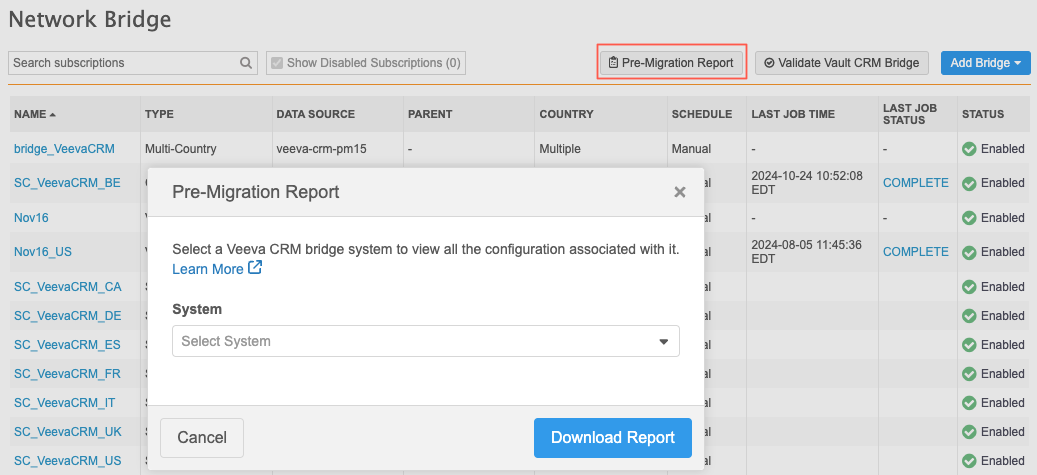
This feature is enabled by default if you have a Veeva CRM Bridge enabled in your Network instance.
Download the report
-
In the Admin console, click System Interfaces > Network Bridge.
-
On the Network Bridge page, click the Pre-Migration Report button.
The button displays if there are active Veeva CRM bridges in your Network instance.
-
On the Pre-Migration Report popup, select a Veeva CRM system.
-
Click Download Report.
A Microsoft Excel file is saved to your local computer with the following naming convention: pre-migration_report_<Veeva CRM system name>_<download date>.
Pre-migration report
The downloaded report contains two tabs:
-
Configuration
-
SingleCountryBridges
Configuration tab
This tab identifies the features that use the defined Veeva CRM system. Create a new version of these configurations so they apply to Vault CRM.
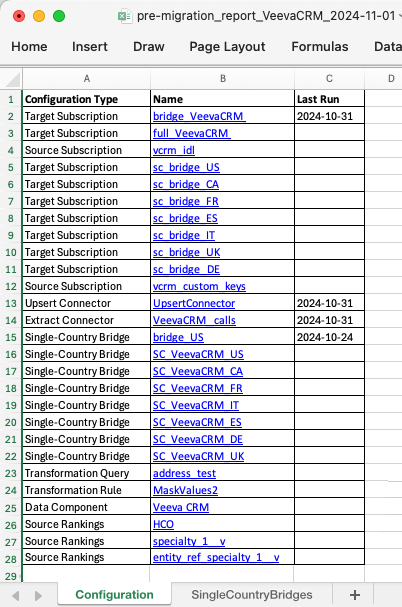
It contains three headings:
-
Configuration Type -The following features are checked to look for the Veeva CRM system. Only enabled configurations are included. If there are multiple configurations of the same type, a row displays for each configuration.
Configuration Details Source subscriptions Checks for source subscriptions that use the system. Single-Country Bridges Checks for any bridge configurations that use the system. Multi-Country Bridges Checks for any bridge configurations that use the system. Transformation Rules Checks for rules that use the system. Source Rankings Checks for any object or field where the system is ranked. Connectors (Upsert and Extract) Checks any enabled connectors that use the system. Saved Reports Checks for a reference to the system with the SQL query. Transformation Queries Checks for references to the system within the query itself or if the query is applied to a target subscription that uses the system. Target Subscriptions Checks if the export is assigned to the system or if the system is referenced in the filters. Data Components Checks the query of any Network reporting data components that reference the system.
SingleCountryBridge tab
If you are currently using single country bridges for your Veeva CRM integration, you should consolidate the bridges into one or more multi-country bridges for Vault CRM.
This tab lists each single country bridge and its related target subscription to help you understand their similarities and differences. For example, you might group bridges together if the target subscriptions for the single bridges are the same except for the defined country.
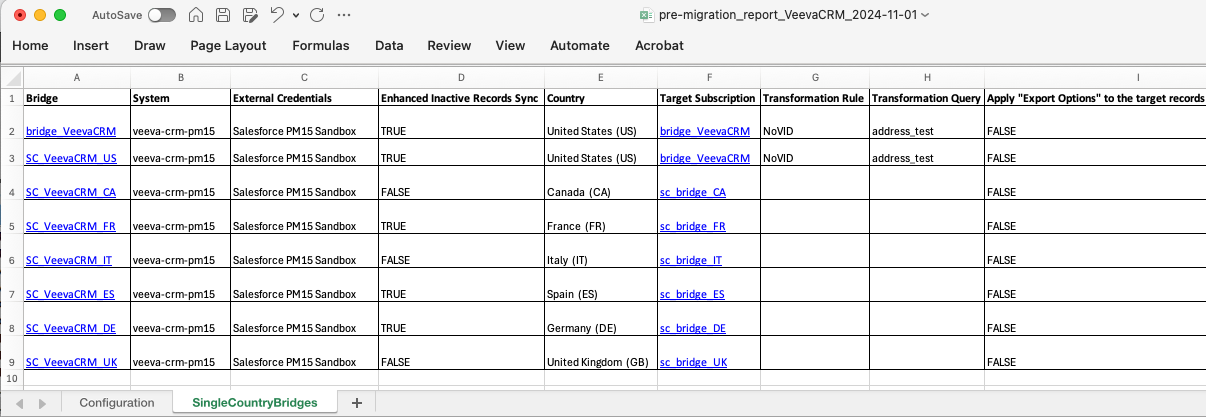
This tab contains the following headings:
| Heading | Details |
|---|---|
| Bridge | The name of each single country bridge. Click the name to open the bridge configuration in a new browser tab. |
| System | The Veeva CRM system assigned to the bridge configuration. This is the system that you selected for the pre-migration assessment report. |
| External Credentials | The Salesforce credentials assigned to the single country bridge. |
| Enhanced Inactive Records Sync | A setting that controls how inactive records are updated in Vault CRM. |
| Country | The country assigned to the bridge. |
| Target Subscription | The target subscription assigned to the bridge. Click the name to open the target subscription configuration in a new browser tab. |
| Transformation Rule | The rule, if any, that is applied to the bridge. |
| Transformation Query | The query applied to the bridge. |
| Apply "Export Options" to the target records related entities | The setting on the target subscription that controls whether related entities are filtered based on the export options. |
| Last Job Date/Time | The last time that the bridge job ran. |
| HCP Export Options | The export options listed for HCPs in the target subscription. |
| HCO Export Options | The export options listed for HCOs in the target subscription. |
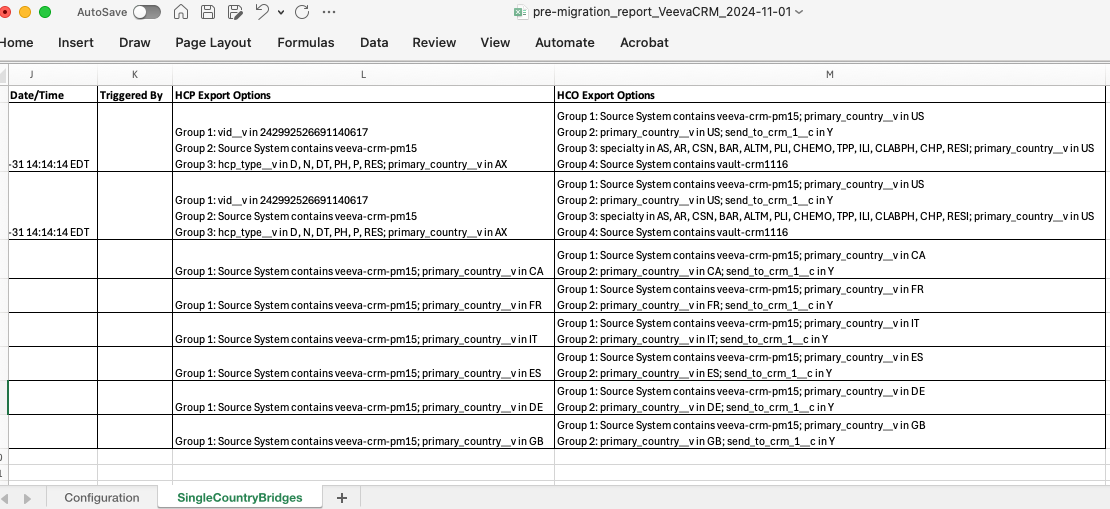
Create unverified accounts
When users submit an add request, the record can be immediately created as an unverified account in Vault CRM so users can quickly interact with and update the account while the DCR is sent to Network for processing.
Administrators must configure Vault CRM and Network to support unverified records.
Requirements
Settings must be enabled in Vault CRM and in Network to create unverified accounts.
Vault CRM
The following setting must be configured:
-
Data Change Request Mode custom setting must be set to 2.
For details, see Vault CRM Help: Creating Unverified Records.
Network setting
-
Enable the Create Unverified setting (Settings > Workflow Settings).
About the process
When the settings are configured, an add account request can immediately create records, including an unverified VID. The record is set to under_review__v state. When the record has been processed and approved in Network, the record state is updated.
This setting must be enabled for users to make changes to unverified records; otherwise, change requests are automatically rejected.
Supported objects
Unverified records can be created for all Vault CRM accounts:
-
HCPs
-
HCOs
-
Addresses
-
Child Accounts
Match and merge considerations
An unverified account can match to an existing account in Network and result in a merge (add request becomes a change request ).
-
If the winning account does not exist in Vault CRM, the losing account ID is updated to the winning account ID.
-
If the winning account is in Vault CRM, the losing account will be merged to the winner in Vault.
Rejected add requests
If the add request is rejected, the unverified account is deactivated and removed from the territory in Vault CRM.
Validate the Vault CRM Bridge
Administrators and Data Managers can validate the Vault CRM bridge to ensure that it is properly configured with the required mappings.
The integration between Vault CRM and Network relies on mappings that are managed in CRM. If the mappings are not configured properly, there can be errors when the bridge attempts to upsert data to CRM and when processing data change requests. The validation helps to identify issues in your existing mappings and find any possible missing mappings.
The Validate Vault CRM Bridge feature creates a report that contains the configuration details and the mappings between Veeva Vault and Network. Use the report to identify and create any missing mappings. If issues are found, fix them and load the mappings into Vault CRM. Run the validation again to ensure that the bridge has no issues.

This enhancement is enabled by default in your Network instance.
About Vault CRM and Network mappings
Mappings are created in Vault CRM. There are four types of mappings that are required between Vault CRM and Network.
-
Network Mapping - Maps the countries to the Network integration user.
-
Network Object Mapping - Maps the Vault CRM Object API Name to the Network Object API Name
-
Network Field Mapping - Maps the Vault CRM Field API Name to Network API Name
-
Network Reference Mapping - Maps Network reference codes to Vault CRM picklist values.
For more information, see the Network Mapping Overview topic in the Vault CRM Online Help.
About the Bridge validation
During the bridge validation, the configuration and data is extracted from Vault CRM. The extracted data is compared to the Network configuration and identifies any invalid object, field, and reference mappings.
This validation includes what is currently done in Veeva CRM. This features enhances the validation by also identifying missing reference mappings. Missing reference mappings can cause records to fail to be upserted to Vault CRM.
All issues are noted in the file that is generated by the validation job. The Validation Status and Validation Notes fields on the mapping objects in Vault CRM will also be updated with the results of the validation (just as they are when using the Veeva CRM validation).
For details, see the Review the validation file section below.
Validate the Vault CRM bridge
To run the Vault CRM bridge validation:
-
On the Network Bridge page, click Validate Vault CRM Bridge.
The button displays only if you have a Vault CRM Bridge configured in your Network instance.
-
Beside Validate Vault CRM, expand the list and select the external credential for the vault that you want to validate.
-
Click Start Validation.
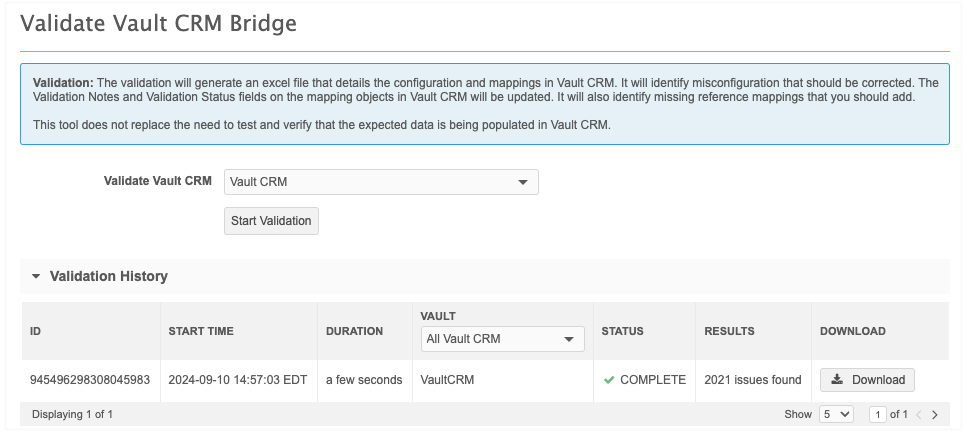
-
If issues are found, a count displays in the Results column.
-
Click the Download button to download and view the .xlsx file that is created.
A Microsoft Excel file is downloaded to your local computer with the following naming convention: bridge-validation_<Vault_name>_<date>_<job ID>
For example: bridge-validation_VaultCRM_2024-09-06_945473961016495263
-
Review the file to see the issues.
Review the validation file
Use the Microsoft Excel® to view any issues and recommendations. You can add or correct any reference mappings and then upload the updates to Vault CRM.
The file contains up to six sheets:
-
Summary
-
Network Mapping
-
Network Object Mapping
-
Network Field Mapping
-
Network Reference Mapping
-
Missing Network Ref. Mapping (included only if there are missing reference mappings)
Details about each sheet are in the sections below.
Summary
This sheet provides an overview of the Vault CRM validation details.
Example
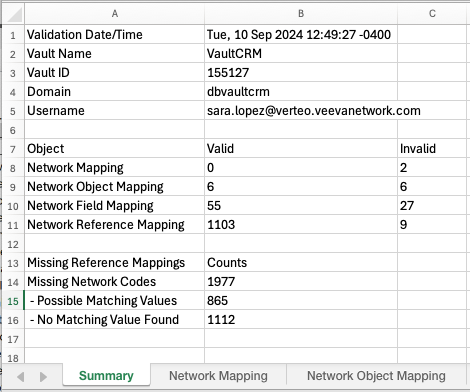
The sheet contains the following details.
| Header | Details |
|---|---|
| Validation Date/Time | The time that the Bridge validation occurred. The time displays in the user's timezone (My Profile). |
| Vault Name | The name of the Vault mapped to this Vault CRM bridge. |
| Vault ID | The ID of the Vault mapped to this Vault CRM bridge. |
| Domain | The domain name of the Vault |
| Username | The name of the Vault integration user. |
| Object | Valid / Invalid (Count of mapping records that are Valid or Invalid) |
| Network Mapping
(summary of data from the network_mapping__v object) |
|
| Network Object Mapping
(summary of data from the network__object_mapping__v object) |
|
| Network Field Mapping
(summary of data from the network__field_mapping__v object) |
|
| Network Reference Mapping
(summary of data from the network__reference_mapping__v object) |
|
| Missing Reference Mapping | Counts (Summary of Network codes missing from the Network Reference Mappings) |
| Missing Network Codes
(Total count of the missing Network codes) |
|
| - Possible Matching Values (Missing Network codes with possible matching values) |
|
| - No Matching Value Found
(Missing Network codes with no matching value) |
Network mapping
This sheet contains the extracted data from the Vault CRM network_mapping__v object. For more information about the fields and data, see Network Mapping in the Vault CRM Online Help.
The job checks that the Network integration user has access to the countries that are mapped to Vault CRM. Use the validation_status__v and validation_notes__v columns to see the issues.

Example issues:
| Issue | Details |
|---|---|
| At least one related object mapping is invalid | One of the related network object mapping records for this mapping is not valid. |
| Missing data visibility profiles | The Network Integration user does not have a Data Visibility Profile assigned for at least one of the countries specified in this mapping. |
Network object mapping
This sheet contains data extracted from the Vault CRM network_object_mapping__v object. For details, see Network Object Mapping in the Vault CRM Online Help.
The job validates that CRM Object API Name and Network Object API Name fields have the correct objects and that they are properly mapped.

Example issues:
| Issue | Details |
|---|---|
| At least one related field mapping is invalid | One of the related Network field mapping records for this mapping is not valid. |
| Network object <network_object_api_name__v> does not exist or is not supported |
The |
| Network object <network_object_api_name__v> does not exist or is not supported | The network_object_api_name__v field is not populated with any of the following values: HCP, HCO, Address, or ParentHCO. |
| CRM object <crm_object_api_name__v> does not exist or is not supported | The crm_object_api_name__v field is not populated with any of the following values: account__v, address__v, or child_account__v. |
| External ID field <{crm_field_api_name__v> does not exist on CRM object | The external_id_api_name__v field is not populated with a field that exists on the CRM object specified in crm_object_api_name__v. |
Network Field Mapping
This sheet contains data extracted from the Vault CRM network_field_mapping__v object. For details, see Network Field Mapping in the Vault CRM Online Help.
It displays the fields that are mapped from the Vault CRM objects (account__v, address__v, or child_account__v) to fields on Network objects (HCP, HCO, ADDRESS, PARENTHCO).

Example issues:
| Issue | Details |
|---|---|
| Field <network_field_api_name__v> does not exist on Network object | The field in the network_field_api_name__v column does not exist or is not active for at least one of the countries in the mapping. |
| Field <crm_field_api_name__v> does not exist on CRM object |
The field in the crm_field_api_name__v column does not exist in Vault CRM. |
| Incorrect field mapping type (<0>) for combination of Network field of type (<1>) and CRM field of type (<2>) | The data types of the Vault CRM and Network fields are incompatible. |
| At least one missing reference mapping | An active Network reference code is not properly mapped. |
| At least one related reference mapping is invalid | An active Network reference code is not properly mapped. |
Network Reference Mapping
This sheet contains data extracted from the Vault CRM network_reference_mapping__v object. For details about the data, see Network Reference Mapping in the Vault CRM Online Help.
The validation job ensures that the Network reference codes are correctly mapped to Vault CRM picklist values and also checks for missing mappings.

Example issues:
| Issue (validation_notes__v) | Details |
|---|---|
| Object type is not correct, it should be <correct object type> | The object type listed in the object_type__v.api_name__v column is incorrect. |
| Picklist value (<0>) does not exist on CRM field (<1>) |
The value in the crm_picklist_value__v column is incorrect or is not active value. |
| Lookup value (<0>) does not exist in field (<1>) on CRM object (<2>) | The value in the crm_lookup_id__v column does not a valid record ID. |
| Reference code (<0>) does not exist on Network field (<1>) | The network_reference_code__v column does not have an active Network code for the Network field for at least one of the mapped countries. |
Missing Network Ref. Mapping
This sheet identifies all the missing reference mappings between Network and Vault CRM.
All active Network Codes for the mapped countries should have a reference mapping. If there is no mapping for the code, the record will fail when Network upserts the data through the bridge or DCR.
For picklist fields, the validation job does a direct comparison of the Network codes and labels to CRM picklists and labels to find a suggested picklist value in Vault CRM to map to.
Key columns
-
Match Notes -Identifies if potential matches are found between Network codes and labels and CRM picklists and labels.
-
crm_picklist value - The suggested picklist value.
-
CRM Picklist Label - The suggested picklist label.
The sheet contains the following columns and values.
| Header | Details | Example value |
|---|---|---|
| Country | The country__v field value from the network_mapping__v record. |
US;CA |
| CRM Object | The crm_object_api_name__v field from the network_object_mapping__v record. |
account__v |
| Person Account | The person_account__v field from the network_object_mapping__v record. |
true |
| Network Field API Name | The network_field_api_name__v from the network_field_mapping__v record. |
speciality_1__v |
| CRM Field API Name | The crm_field_api_name__v from the network_field_mapping__v record. |
speciality_1__v |
| Vault Picklist | The name of the picklist associated with the CRM field. | account_speciality_1__v |
| network_reference_code__v | The missing reference code | O |
| Network English Label | Network's English label for the code. | Other |
| Match Notes | Advises of any possible matches to CRM picklists. | Found matching picklist value name in Vault. |
| crm_picklist_value__v | Possible matching CRM picklist value. | o__c |
| CRM Picklist Label | CRM's English picklist label. | Other |
| crm_lookup_id__v | Vault CRM lookup ID | |
| crm_record_type_name__v | Vault CRM object type name | |
| direction__v | Supported mapping direction | bidirectional__v |
| object_type__v.api_name__v | The API name of the object type the reference mapping should have. | picklist__v |
| external_id__v | Customer defined unique identifier for the mapping. Helpful for loading mappings to different vaults. | NFM-US-Account-HCP-credentials__v-o__c-Other |
| network_field_mapping__v | ID of the network_field_mapping__v record. | VA5000000001012 |
| network_field_mapping__v.external_id__v | external_id__v value from the network_field_mapping__v record | NFM-US-Account-HCP-credentials__v |
| network_field_mapping__v.legacy_crm_id__v | legacy_crm_id__v value from the network_field_mapping__v record | a2436000000AQI0AAO |
Example sheet

Matching missing reference values
When missing reference values are found, the validation job compares the extracted Vault CRM data to try to find a recommended mapping.
Network to CRM data comparison
| network_reference_code__v | crm_picklist_value__v |
| Network English Label | CRM Picklist Label |
The logic to match the data is prioritized to find the best mapping. Network codes that are matched to CRM Picklist names are considered the best match.
Example
| Order | Network Code | Network Label (EN) | CRM Picklist Name | CRM Picklist Label | Logic |
|---|---|---|---|---|---|
| 1 | MD | Doctor of Medicine | md__c | Dr of Med | Network Code == CRM Picklist Name minus suffix (__v, __c, __cda, _cda) |
| 2 | MD | Doctor of Medicine | abc__c | MD | Network Code == CRM Picklist Label |
| 3 | MD | Doctor of Medicine | abc__c | Doctor of Medicine | Network English Label == CRM Picklist Label |
| 4 | MD | Doctor of Medicine | doctor_of_medicine__c | Dr of Medicine | Network English Label == CRM Picklist Name minus suffix (__v, __c, __cda, _cda), replace underscores with spaces |
Resolve the issues
You can change any configuration issues or mappings directly in the file and then upload the updates to Vault CRM.
Note: If your mapping has an incorrect object_type__v, you cannot update the mapping through data loader. You can delete and then recreate the mapping with the correct object type.
-
Update the validation file to correct the issues.
-
Save the file as .csv.
-
Load the .csv file into Vault CRM (Vault Loader) to update the mappings.
-
In Network, click Validate Vault CRM Bridge again to ensure that all mapped data is validated.
Continue these steps until there are no issues found.